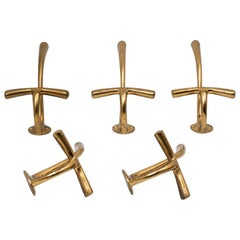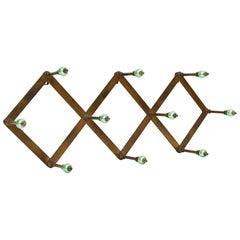Azucena Hooks
Recent Sales
Vintage 1950s Italian Mid-Century Modern Coat Racks and Stands
Brass
Vintage 1950s Italian Mid-Century Modern Coat Racks and Stands
Brass
Vintage 1960s Italian Architectural Elements
Metal
Vintage 1960s Coat Racks and Stands
Brass
Azucena for sale on 1stDibs
Vintage Azucena furniture is elegant and inviting — the esteemed mid-century Milanese manufacturer’s wall lights, armchairs and side tables, which are marked by simple symmetry and thoughtfully contrasting materials, can likely be found in the living rooms of design lovers all over Italy.
Azucena was founded in 1947 by three leading figures of 20th-century Italian architecture: Luigi Caccia Dominioni, Ignazio Gardella and Corrado Corradi Dell’Acqua. The trio initially established Azucena in order to furnish the interiors of buildings they’d designed but found a robust business opportunity in manufacturing individual pieces from those collections for postwar consumers. And as the company founders borrowed the brand name from a conniving character in the Giuseppe Verd opera Il Trovatore, it is appropriate, then, that the furniture for which Azucena is known is practical but exudes a hint of playfulness.
The best of Italian modernism combines cheekiness and bold functionality with provocative and thoughtful design, and Azucena is deeply rooted in that tradition. While its brass-and-walnut mid-century-modern-era dining tables and stackable coffee tables — created by the likes of Dell’Acqua and Vico Magistretti — are exceptionally unobtrusive in small spaces and framed in clean lines, Dominioni designed chunky, enveloping armchairs during the 1970s upholstered in striking red fabric.
Among Azucena's most successful and iconic designs is also Dominioni's most famous piece of furniture: the minimalist Catalina chair. After it debuted at the Milan Triennial in 1957, the Catalina chair, with its generously curving enameled steel frame and plush leather cushion, became an instant sensation. Dominioni’s other enduring designs for Azucena include the Monachella lamp, the ABCD armchair and the versatile Cilindro ottoman.
Italian furniture manufacturer B&B Italia acquired Azucena in 2018 and has reissued a number of designs from the legendary brand’s portfolio, such as the Imbuto lamp, the Catalina armchair and the Cavalletto table.
On 1stDibs, find vintage Azucena lighting, tables, seating and more.
A Close Look at Mid-century-modern Furniture
Organically shaped, clean-lined and elegantly simple are three terms that well describe vintage mid-century modern furniture. The style, which emerged primarily in the years following World War II, is characterized by pieces that were conceived and made in an energetic, optimistic spirit by creators who believed that good design was an essential part of good living.
ORIGINS OF MID-CENTURY MODERN FURNITURE DESIGN
- Emerged during the mid-20th century
- Informed by European modernism, Bauhaus, International style, Scandinavian modernism and Frank Lloyd Wright’s architecture
- A heyday of innovation in postwar America
- Experimentation with new ideas, new materials and new forms flourished in Scandinavia, Italy, the former Czechoslovakia and elsewhere in Europe
CHARACTERISTICS OF MID-CENTURY MODERN FURNITURE DESIGN
- Simplicity, organic forms, clean lines
- A blend of neutral and bold Pop art colors
- Use of natural and man-made materials — alluring woods such as teak, rosewood and oak; steel, fiberglass and molded plywood
- Light-filled spaces with colorful upholstery
- Glass walls and an emphasis on the outdoors
- Promotion of functionality
MID-CENTURY MODERN FURNITURE DESIGNERS TO KNOW
- Charles and Ray Eames
- Eero Saarinen
- Milo Baughman
- Florence Knoll
- Harry Bertoia
- Isamu Noguchi
- George Nelson
- Danish modernists Hans Wegner and Arne Jacobsen, whose emphasis on natural materials and craftsmanship influenced American designers and vice versa
ICONIC MID-CENTURY MODERN FURNITURE DESIGNS
- Eames lounge chair
- Nelson daybed
- Florence Knoll sofa
- Egg chair
- Womb chair
- Noguchi coffee table
- Barcelona chair
VINTAGE MID-CENTURY MODERN FURNITURE ON 1STDIBS
The mid-century modern era saw leagues of postwar American architects and designers animated by new ideas and new technology. The lean, functionalist International-style architecture of Le Corbusier and Bauhaus eminences Ludwig Mies van der Rohe and Walter Gropius had been promoted in the United States during the 1930s by Philip Johnson and others. New building techniques, such as “post-and-beam” construction, allowed the International-style schemes to be realized on a small scale in open-plan houses with long walls of glass.
Materials developed for wartime use became available for domestic goods and were incorporated into mid-century modern furniture designs. Charles and Ray Eames and Eero Saarinen, who had experimented extensively with molded plywood, eagerly embraced fiberglass for pieces such as the La Chaise and the Womb chair, respectively.
Architect, writer and designer George Nelson created with his team shades for the Bubble lamp using a new translucent polymer skin and, as design director at Herman Miller, recruited the Eameses, Alexander Girard and others for projects at the legendary Michigan furniture manufacturer.
Harry Bertoia and Isamu Noguchi devised chairs and tables built of wire mesh and wire struts. Materials were repurposed too: The Danish-born designer Jens Risom created a line of chairs using surplus parachute straps for webbed seats and backrests.
The Risom lounge chair was among the first pieces of furniture commissioned and produced by celebrated manufacturer Knoll, a chief influencer in the rise of modern design in the United States, thanks to the work of Florence Knoll, the pioneering architect and designer who made the firm a leader in its field. The seating that Knoll created for office spaces — as well as pieces designed by Florence initially for commercial clients — soon became desirable for the home.
As the demand for casual, uncluttered furnishings grew, more mid-century furniture designers caught the spirit.
Classically oriented creators such as Edward Wormley, house designer for Dunbar Inc., offered such pieces as the sinuous Listen to Me chaise; the British expatriate T.H. Robsjohn-Gibbings switched gears, creating items such as the tiered, biomorphic Mesa table. There were Young Turks such as Paul McCobb, who designed holistic groups of sleek, blond wood furniture, and Milo Baughman, who espoused a West Coast aesthetic in minimalist teak dining tables and lushly upholstered chairs and sofas with angular steel frames.
Generations turn over, and mid-century modern remains arguably the most popular style going. As the collection of vintage mid-century modern chairs, dressers, coffee tables and other furniture for the living room, dining room, bedroom and elsewhere on 1stDibs demonstrates, this period saw one of the most delightful and dramatic flowerings of creativity in design history.

